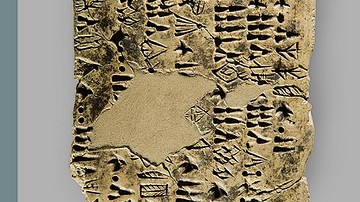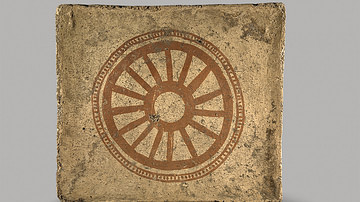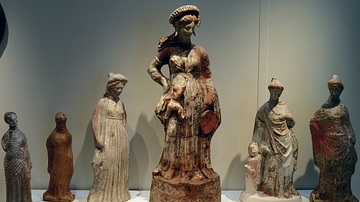Illustration
Terracotta goblet with gazelles and ibexes, found in grave no. 725 in Shahr-e Sukhteh, southern Iran, Early Bronze Age, c. 2800-2400 BCE.
National Museum of Iran, Tehran, acc. no. 12947.
Photo by Nima Fakoorzadeh (Baloot Noghrei)
Shahr-e Sukhteh (lit. = the burnt city) in southern Iran is the site of an ancient city-state dating back to the Late Chalcolithic or Early Bronze Age periods. Several Sumerian mythical epics and hymns, resonated by archaeological evidence, have illuminated Shahr-e Sukhteh as a lustrous hob for industrial activities and trading goods, including precious metals and gemstones. Although hot and mostly arid today, the region used to accommodate overcovering populations of plants and animals thanks to the then much greater Helmand River and its natural reservoir, Lake Hamun. The artistic reflections of proliferating plains and valleys can be watched today on a hoard of painted terracotta vessels retrieved from Shahr-e Sukhteh.
A common motif on these painted pieces is that of the male adult ibex, quite frequent in Near Eastern rock art since thousands of years before its transference to pot-painting first emerged on the Samarran ware c. 5500 BCE in Mesopotamia. Many scholars have considered the ibex motif as bearing a symbolic, religious content that can converse with a variety of concepts including the (worship of) Mesopotamian moon god, Sin; power and strength; rejuvenation and fertility; and the Tree of Life (often depicted in the form of a palm tree). The ibex motifs from the proto-Elamite Shahr-e Sukhte, however, are distinctive from their earlier Mesopotamian peers in terms of the animated style of their illustration that delivers a sense of motion, particularly on spinnable goblets like the one exhibited here.
References
- Federico Mailland. "Ibex, Crescent, and Swastika as Symbols of Lunar God in the Ancient Near East and Mesopotamia." Expression, no. 10, 2015.
- Richard Dibon-Smith. "The ibex as an Iconographic Symbol in the Ancient Near East." self-published, 2015.
Cite This Work
APA Style
Iran, N. M. o. (2024, March 26). Terracotta Goblet with Gazelles and Ibexes from Shahr-e Sukhteh, Iran. World History Encyclopedia. Retrieved from https://www.worldhistory.org/image/18741/terracotta-goblet-with-gazelles-and-ibexes-from-sh/
Chicago Style
Iran, National Museum of. "Terracotta Goblet with Gazelles and Ibexes from Shahr-e Sukhteh, Iran." World History Encyclopedia. Last modified March 26, 2024. https://www.worldhistory.org/image/18741/terracotta-goblet-with-gazelles-and-ibexes-from-sh/.
MLA Style
Iran, National Museum of. "Terracotta Goblet with Gazelles and Ibexes from Shahr-e Sukhteh, Iran." World History Encyclopedia. World History Encyclopedia, 26 Mar 2024. Web. 11 May 2024.






